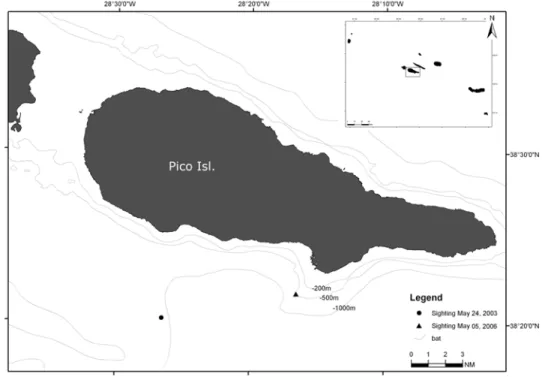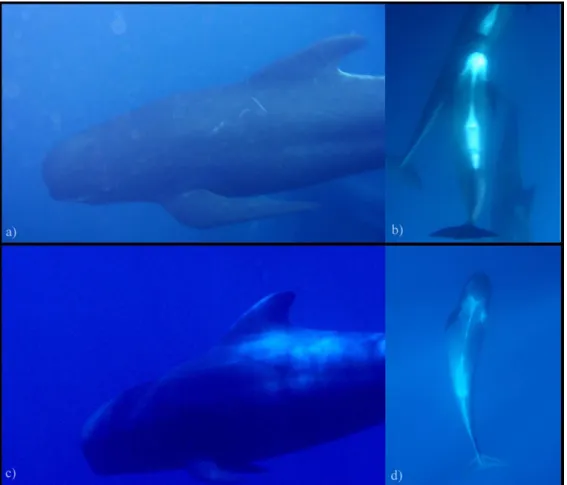SHORT COMMUNICATION
Revision of the occurrence of the long‐finned pilot whale
Globicephala melas (Traill, 1809), in the Azores
RUI PRIETO & MANUEL FERNANDES
Prieto, R. & M. Fernandes 2007. Revision of the occurrence of the long-finned pilot whale Globicephala melas (Traill, 1809), in the Azores. Arquipélago. Life and Marine Sciences 24: 65-69.
Although the expected distribution of the long-finned pilot whale in the Atlantic includes the Azores, overlapping with the known northern distribution of the short-finned pilot whale, the only documental references to the species in the archipelago are based on a single specimen captured in 1894. Moreover, a clear distinction between the two species of pilot-whales based on osteological grounds was only possible after 1971 and before that a great uncertainty existed about the phylogeny of the Genus. The long-finned pilot whale, thus, has never been confirmed by sightings at sea in the region and the extent of its occurrence to the South in the central North Atlantic has been, up to now, an open issue. Here we present evidence of the occurrence of the long-finned pilot whale in the Azores, based on two sightings made in different years.
Rui Prieto (e-mail: rprieto@.uac.pt), Departamento de Oceanografia e Pescas, Universidade dos Açores, Cais de Sta Cruz, PT-9901-862 Horta, Açores, Portugal; Manuel C. Fernandes, SCIAENA - Marine Sciences and Cooperation, Av. General Humberto Delgado, no.23 6ºDto, PT-2560-272 Torres Vedras, Portugal.
INTRODUCTION
The long-finned pilot whale, Globicephala melas (Traill, 1809), has two subspecies, G. m. edwardii (A. Smith, 1834) and G. m. melas. The former is circumglobal in the southern hemisphere whilst the latter is restricted to the North Atlantic and western Mediterranean (Leatherwood & Reeves 1983; Cawardine 1995).
In the North Atlantic, the long-finned pilot whale is widely distributed from roughly 35°N to 65°N in the western Atlantic, and from 40°N to 75°N in the eastern Atlantic. The species occurs regularly along the continental shelf break, usually in deeper pelagic waters, but also in the open ocean away from continental land masses (Abend & Smith 1999).
The distribution of this species overlaps with that of short-finned pilot whales (G.
macrorhynchus Gray, 1846) along the U.S. coast
in the region from 35°N to 40°N, and along the French and Spanish Atlantic coasts from roughly 40°N to 45°N, but the distributional overlap in the central North Atlantic is unknown (Abend & Smith 1999).
Although the expected distribution of G. melas includes the Azores (Clarke 1981; Abend & Smith 1999), a Portuguese archipelago located in the Mid Atlantic Ridge between 37º and 41ºN, the only references to the species in the archipelago are ambiguous and outdated.
The occurrence or pilot whales in the Azores, was first referred by Drouët (1861) and van Beneden (1889 in Clarke 1981). In a revision of cetacean species of the Azores, Chaves (1924) establishes the presence of the long-finned pilot whale in two ways: he assumes that the description of “black-fish” made by Drouët
(1861) corresponds to Globicephalus melas Flower (a synonym of Globicephala melas) and refers to a foetus preserved in the Carlos Machado Museum collection (specimen MRCM no. 182) captured in 1894 off São Miguel Island. Since a clear distinction between the two species of pilot whales was only possible after the work by Van Bree (1971) and since the short-finned pilot whale occurs yearly in the Azores, during summer and autumn months (Reiner 1988; Gonçalves et al. 1992; Silva et al. 2003), it is possible that the specimen preserved in the Carlos Machado Museum, and labelled as G. melas, was misidentified.
Unfortunately, due to the deformation caused by the preservation process and lack of data on the foetal ontogeny of the two pilot whale species, a correct species assignment of the specimen is now difficult.
Most of the subsequent works that refer the long-finned pilot whale for the Azores (Ferreira 1935; Clarke 1981; Reiner 1988; Reiner et al. 1993) rely on the above accounts by Drouët, van Beneden and Chaves. Santos-Reis & Mathias (1996) state that the long-finned pilot whale is a
common species in the Azores but provide no evidence or references for that affirmation. The long-finned pilot whale, thus, has never been confirmed by sightings at sea in the region and the extent of its occurrence to the South in the central North Atlantic has been, up to now, an open issue (Abend & Smith 1999).
Here we present evidence of the occurrence of the long-finned pilot whale in the Azores, based in two sightings made in different years.
MATERIAL AND METHODS
Sightings were recorded by one of the authors (M. Fernandes) during commercial whale watching trips. Species identification was made through visual inspection of the pectoral fins and ventral pigmentation. Underwater pictures were taken with Canon Powershot A20 and S50 digital cameras using underwater housings, for subsequent reconfirmation of species identification. The exact geographical position of the sightings was not recorded. Approximate distance to the coast was estimated based on
information given by land-based lookouts working for the whale watching companies. RESULTS
Two sightings of G. melas were recorded in different years, south of Pico Island (Fig. 1). The first sighting occurred during the afternoon on 24 May 2003, at an approximate distance of three nautical miles off Silveira, on the south coast of Pico island. The group sighted comprised more than 100 individuals, including adult ani-mals and calves, traveling eastwards along the coast at an approximate speed of 4 knots.
The sighting lasted about 20 minutes and the animals approached the boat several times allowing close inspection of the pectoral fins and ventral pigmentation.
The second sighting occurred in the morning on 05 of May 2006, at an approximate distance of five nautical miles off São Mateus, in the south coast of Pico island. The group comprised around 20 animals including adults and calves. The animals were socializing and several aerial displays were observed. The group approached the boat several times, allowing close inspection of the pectoral fins and ventral pigmentation. This sighting also lasted around 20 minutes.
Fig. 2. Lateral (a) and ventral (b) views of Globicephala melas from sighting made 3 nautical miles south of Pico Island on 24 May 2003 (photos M. Fernandes). Lateral (c) and ventral (d) views of G. macrorhynchus photographed in the Azores (photos J. Fontes / ImagDOP). Notice relative longer pectoral fins and brighter ventral pigmentation in G. melas, when compared with G. macrorhynchus.
DISCUSSION
In adult long-finned pilot whales fins range from 18 to 27% of the total body length and there is a clear white or light grey kedge-shaped throat mark with a streak extending to the inguinal area. In adult short-finned pilot whales the pectoral fins are shorter, between 14 and 19% of the body length, and the ventral colour pattern, although similar in shape, is much darker and less conspicuous (Sergeant 1962; Van Bree 1971; Bloch et al. 1993). When seen, these characteristics are enough for a trained observer to determine the species.
During the two sightings reported here, there was opportunity to observe the relative size and ventral pigmentation of the animals when they approached the vessels. The underwater pictures taken also aided in confirming the species identification. When compared with similar pictures of G. macrorhynchus, the difference in the relative size of the pectoral fins and contrast of the ventral pigmentation is clear (Fig. 2). These two sightings confirm the occurrence of the species in the archipelago, at least sporadically. The fact that they were made with two years of interval gives some support to the idea that the Azores is within the normal range of the species, although the possibility that both sightings can represent abnormal movements cannot be completely ruled out. Although both sightings occurred at the same month in different years (May) no inferences about the frequency and seasonality of the species can be made, due to the scarcity of data.
The confirmation of an overlap of G. melas and
G. macrorhynchus at latitude 38ºN in the central
North Atlantic raises the question about at sea species identification in this region. At sea, distinction of the two species is only possible at close range and with good visibility conditions. Incorrect identification of the species may be reflected on abundance estimates or any other kind of studies where correct species assignment is important.
Further work should be undertaken to study the frequency and seasonality of the species in the area to determine to which extent the two species overlap, spatially and temporally.
ACKNOWLEDGEMENTS
The authors would like to thank the Museu Carlos Machado, in the person of João Pedro Constância, for valuable information and access to the specimen MRCM no. 182. Ana Paixão helped with morphometry of that specimen and we are also indebted for that. The pictures of G.
macrorhynchus in Fig. 2 (c and d) were kindly
provided by Jorge Fontes / ImagDOP. We would also like to thank Espaço Talassa and
Hortacetáceos whale-watching companies,
without which these observations would not be possible to do. We thank the two anonymous referees for their comments which greatly improved the manuscript. Rui Prieto is supported by a FCT Ph.D. fellowship (SFRH/BD/32520/2006). IMAR-DOP/UAÇ (research unit #531 and part of the Associated Laboratory #9) is funded annually by FCT. REFERENCES
Abend, A.G., T.D. Smith 1999. Review of distribution of the long-finned pilot whale (Globicephala
melas) in the North Atlantic and Mediterranean.
Department of Commerce, Northeast Fisheries
Science Center. Woods Hole. 22 pp.
Bloch, D., M. Zachariassen & P. Zachariassen 1993. Some external characters of the long-finned pilot whale off the Faroe Islands and a comparison with the short-finned pilot whale. Reports of the
International Whaling Commission (Special Issue
14): 117-136.
Carwardine, M. 1995. Whales, Dolphins and
Por-poises. Dorling Kindersley, London, UK. 257 pp.
Chaves, F.A. 1924. Cetáceos que aparecem nos mares dos Açores. A Pesca Marítima 15: 41-44.
Clarke, R. 1981. Whales and dolphins of the Azores and their exploitation. Reports of the International
Whaling Commission 31: 607-615.
Drouët, H. 1876. Eléments de la Faune Açoréenne. Société Académique de l’Aube. Paris. 245 pp. Ferreira, E. 1935. Gigantes dos mares dos Açores.
Açoreana 2: 74-85.
Gonçalves, J.M., L. Galhardo & J. Brum 1992. Marine mammals stranded in the Azores during 1990-91.
Arquipélago - Life and Earth Sciences 10: 113-118.
Leatherwood, S., R.R. Reeves. 1983. The Sierra Club
Handbook of Whales and Dolphins. Sierra Club
Reiner, F., J.M. Gonçalves & R.S. Santos 1993. Two new records of Ziphiidae (Cetacea) for the Azores with an updated checklist of cetacean species.
Arquipélago. Life and Marine Sciences 11A:
113-118.
Reiner, F. 1988 (1990). Records of marine mammals of the Azorean islands. Garcia de Orta - Série
Zoológica 15(2): 21-36.
Santos-Reis, M., M.L. Mathias 1996. The historical and recent distribution and status of mammals in Portugal. Hystrix 8: 75-89.
Sergeant, D.E. 1962 On the external characters of the blackfish or pilot whales (Genus Globicephala).
Journal of Mammalogy 43: 395-413.
Silva, M.A., R. Prieto, S.M. Magalhães, R. Cabecinhas, A. Cruz, J.M. Gonçalves & R.S. Santos 2003. Occurrence and distribution of cetaceans in waters around the Azores (Portugal), Summer and Autumn 1999-2000. Aquatic Mammals 29: 77-83.
Van Bree, P.J.H. 1971. On Globicephala sieboldii Gray, 1846, and other species of pilot whales. Notes on Cetacea, Delphinoidea: III. Beaufortia 19: 79-87.

